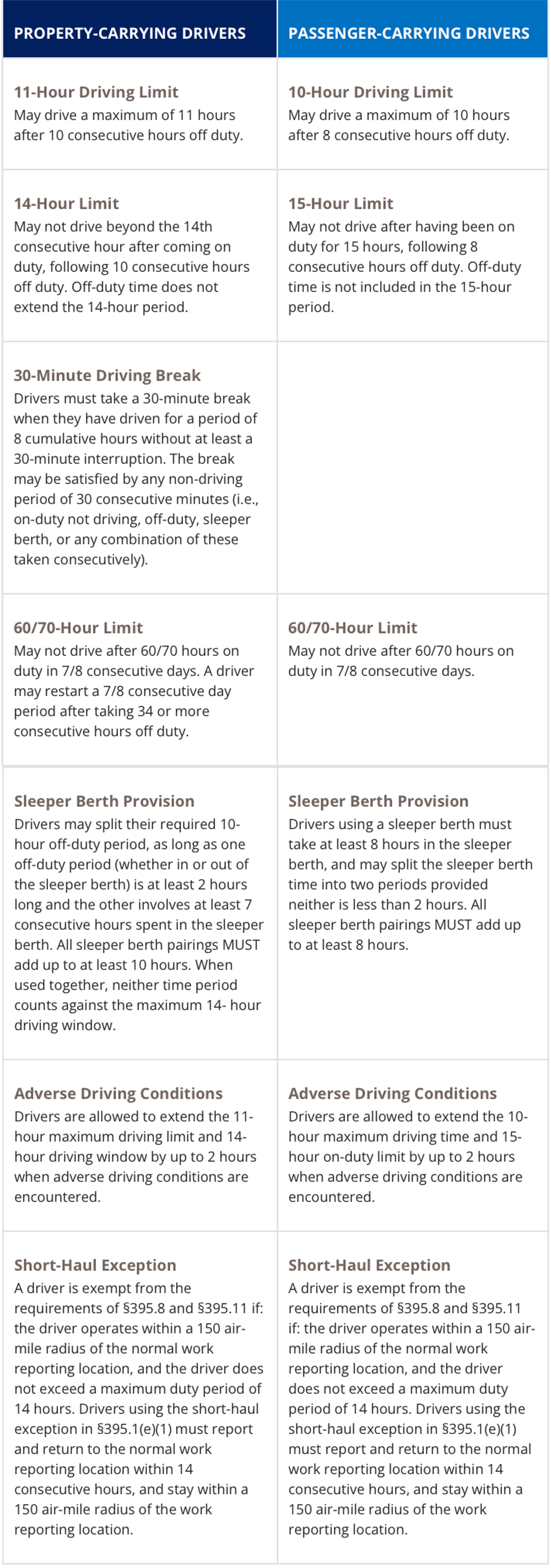13.3 Driver Fatigue
Fatigue can result when you do not get enough sleep or do not get quality sleep. It can impair your driving, similar to alcohol impairment.
- What causes fatigue?
- Being awake for many consecutive hours.
- Not getting enough sleep over multiple days.
- Time of day: Your body has a sleep/wake cycle that tells you when to be alert and when it’s time to sleep. The urge to sleep is the most intense in the early morning hours.
- Monotonous tasks or long periods of inactivity.
- Health factors such as sleep disorders or medications that cause drowsiness.
- What are the effects of driver fatigue?
- Nodding off.
- Reacting more slowly to changing road conditions, other drivers, or pedestrians.
- Making poor decisions.
- Drifting from your lane.
- Experiencing “tunnel vision” (when you lose sense of what’s going on in the periphery)
- Experiencing “microsleeps” (brief sleep episodes lasting from a fraction of a second up to 30 seconds).
- Forgetting the last few miles you drove.
- How to avoid driver fatigue?
- Getting adequate sleep on a daily basis is the only true way to protect yourself against the risks of driving when you’re drowsy. Experts urge consumers to make it a priority to get seven to eight hours of sleep per night.
- Before the start of a long family car trip, get a good night’s sleep, or you could put your entire family and others at risk.
- Many teens do not get enough sleep at a stage in life when their biological need for sleep increases, which makes them vulnerable to the risk of drowsy-driving crashes, especially on longer trips. Advise your teens to delay driving until they’re well-rested.
- Avoid drinking any alcohol before driving. Consumption of alcohol interacts with sleepiness to increase drowsiness and impairment.
- Always check your prescription and over-the-counter medication labels to see if drowsiness could result from their use.
- If you take medications that could cause drowsiness as a side effect, use public transportation when possible.
- If you drive, avoid driving during the peak sleepiness periods (midnight – 6 a.m. and late afternoon). If you must drive during the peak sleepiness periods, stay vigilant for signs of drowsiness, such as crossing over roadway lines or hitting a rumble strip, especially if you’re driving alone.
- Related regulations
While regulations set maximum numbers of driving and work hours for jobs such as driving a large truck, this approach doesn’t account for individual differences in sleep needs and health. Workers in most other jobs aren’t covered by regulations intended to reduce driver fatigue.
Summary of Hours of Service Regulations

Figure 13.4: Hours-of-service regulations
- Related statistics
- NHTSA’s census of fatal crashes and estimate of traffic-related crashes and injuries rely on police and hospital reports to determine the incidence of drowsy-driving crashes. NHTSA estimates that in 2017, 91,000 police-reported crashes involved drowsy drivers. These crashes led to an estimated 50,000 people injured and nearly 800 deaths. But there is broad agreement across the traffic safety, sleep science, and public health communities that this is an underestimate of the impact of drowsy driving.
- Sleepiness can result in crashes any time of the day or night, but three factors are most commonly associated with drowsy-driving crashes. (a) Occur most frequently between midnight and 6 a.m., or in the late afternoon; (b) Often involve only a single driver (and no passengers) running off the road at a high rate of speed with no evidence of braking; (c) Frequently occur on rural roads and highways.
Source: https://www.cdc.gov/niosh/newsroom/feature/driverfatigue.html https://www.cdc.gov/niosh/motorvehicle/topics/driverfatigue/default.html https://www.fmcsa.dot.gov/regulations/hours-service/summary-hours-service-regulations https://www.nhtsa.gov/risky-driving/drowsy-driving